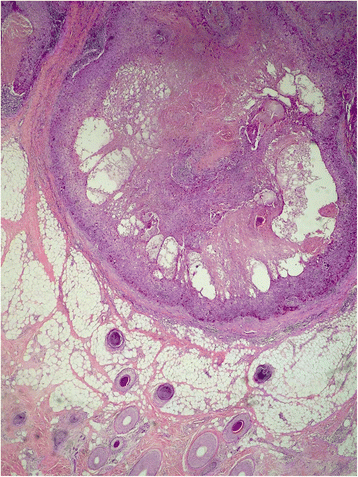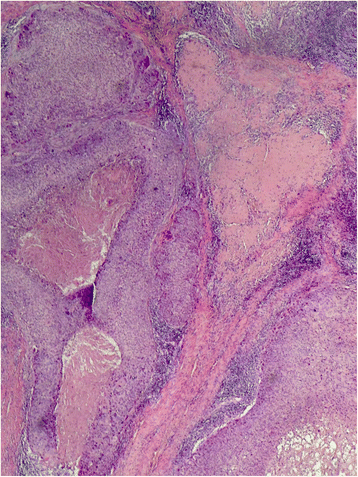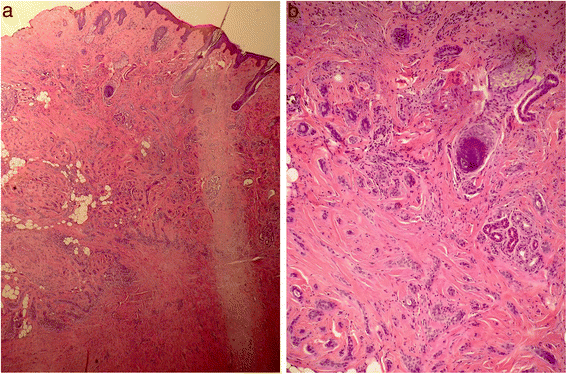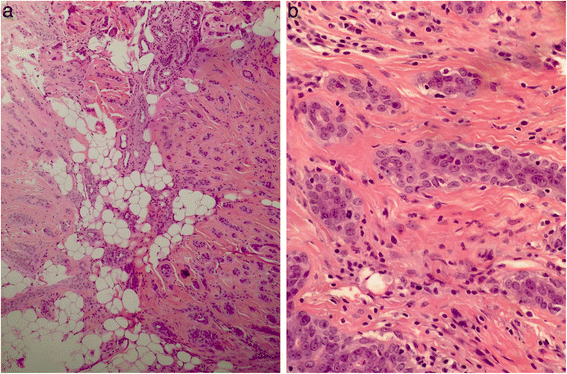Retrospective study of rare cutaneous malignant adnexal tumors of the head and neck in a tertiary care cancer hospital: a case series
- PMID: 28284233
- PMCID: PMC5346454
- DOI: 10.1186/s13256-017-1212-8
Retrospective study of rare cutaneous malignant adnexal tumors of the head and neck in a tertiary care cancer hospital: a case series
Abstract
Background: Adnexal tumors of the skin are a large and diverse group of benign and malignant neoplasms, which exhibit morphological differentiation toward one of the different types of adnexal epithelium present in normal skin and they pose a diagnostic challenge. The purpose of this study is to share our experience with these rare but aggressive tumors at a tertiary care cancer hospital in a developing country. A retrospective review of 11 patients diagnosed with rare adnexal tumors and their variants from January 2005 to December 2014, treated either surgically or non-surgically, was performed to describe the clinicopathological characteristics and outcome of the disease.
Case presentation: A total of 11 patients were diagnosed with adnexal carcinoma and its variants: a 34-year-old Sindhi man, a 59-year-old Punjabi woman, a 32-year-old woman from Khyber Pakhtunkhwa, a 43-year-old Punjabi woman, a 64-year-old Punjabi man, a 51-year-old man from Khyber Pakhtunkhwa, a 51-year-old Punjabi woman, a 74-year-old Punjabi woman, a 75-year-old Punjabi man, a 61-year-old man from Khyber Pakhtunkhwa, and a 53-year-old man from Khyber Pakhtunkhwa. The male to female ratio was 1.2:1. The histological variations were sebaceous differentiation (n = 4), microcystic adnexal carcinoma (n = 4), trichilemmal carcinoma (n = 1), pilomatrix carcinoma (n = 1), and hidradenocarcinoma (n = 1). The mean age at presentation was 54 years (range 32 to 75). The primary subsite of involvement was the scalp in nine patients followed by eyelids in two patients. Surgery was the primary treatment modality in almost all patients; postoperative radiotherapy (PORT) was offered to eight patients. The median dose of radiation was 45 Gy to the primary site. Indications for radiotherapy included close margins (n = 2), positive margins (n = 1), high grade histology (n = 4), and multifocal disease (n = 1). On follow-up, two patients presented with local, one regional and two patients developed distant metastasis.
Conclusions: Adnexal carcinomas are rare tumors with diverse histological patterns and a tendency for locoregional and distant metastasis. Surgery should be the mainstay of treatment reserving radiotherapy for adjuvant, palliative, and re-treatment scenarios.
Keywords: Adnexal carcinoma; Head and neck cancers; Radiotherapy; Skin adnexal tumors.
Figures






References
-
- Abbate M, Zeitouni NC, Seyler M, et al. Clinical course, risk factors, and treatment of microcystic adnexal carcinoma: a short series report. Dermatol Surg. 2003;29:1035–8. - PubMed
Publication types
MeSH terms
LinkOut - more resources
Full Text Sources
Other Literature Sources
Medical

